
How to Use Relay Module 5V 4 CH 30A: Examples, Pinouts, and Specs
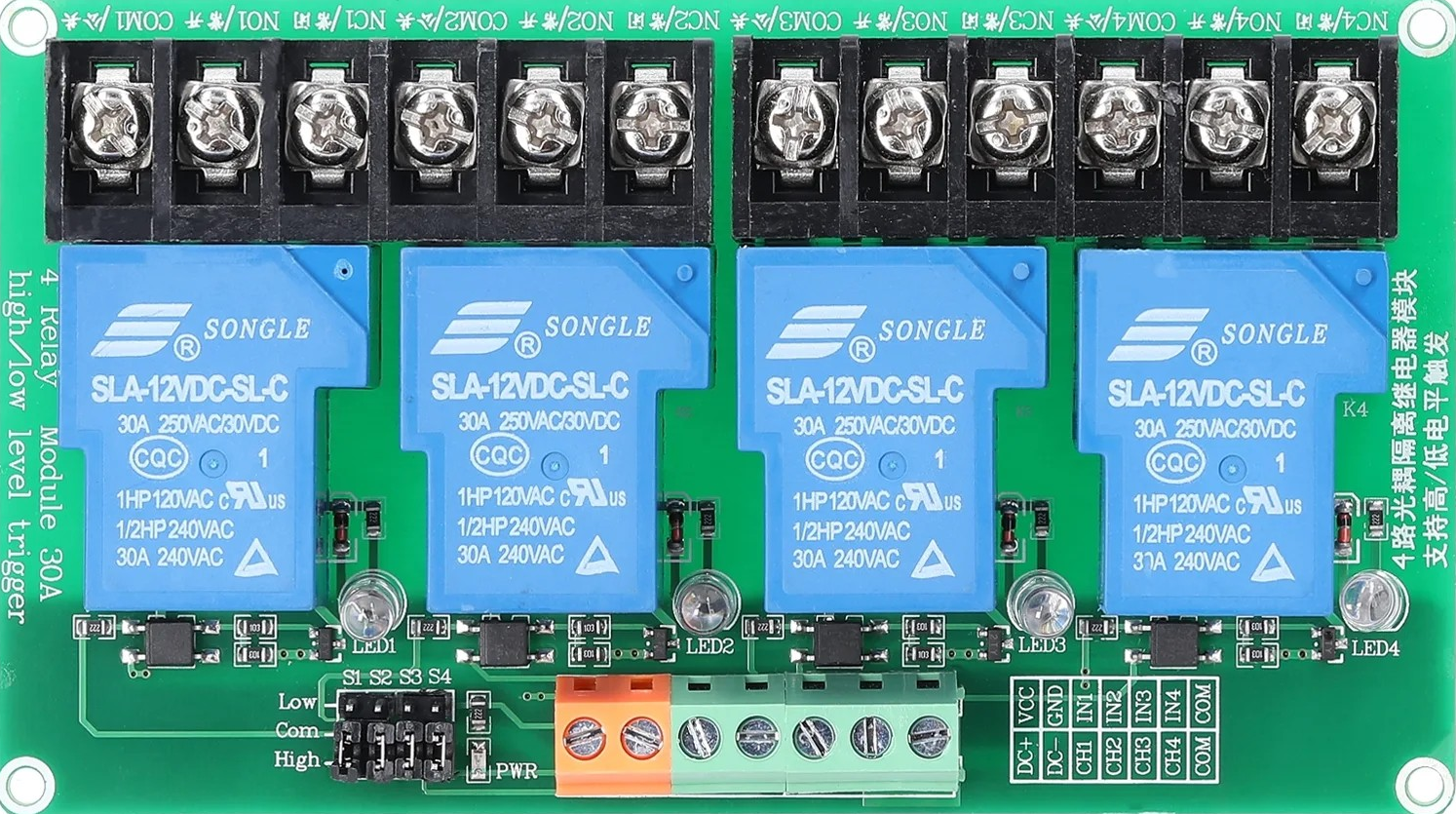
 Design with Relay Module 5V 4 CH 30A in Cirkit Designer
Design with Relay Module 5V 4 CH 30A in Cirkit DesignerIntroduction
The Relay Module 5V 4 CH 30A is a versatile electronic component designed to control high-power devices using low-power control signals. This module features four independent relay channels, each capable of switching loads up to 30A at 250V AC or 30V DC. It is widely used in home automation, industrial control systems, and DIY projects to interface microcontrollers or low-voltage circuits with high-power devices such as motors, lights, and appliances.
Explore Projects Built with Relay Module 5V 4 CH 30A
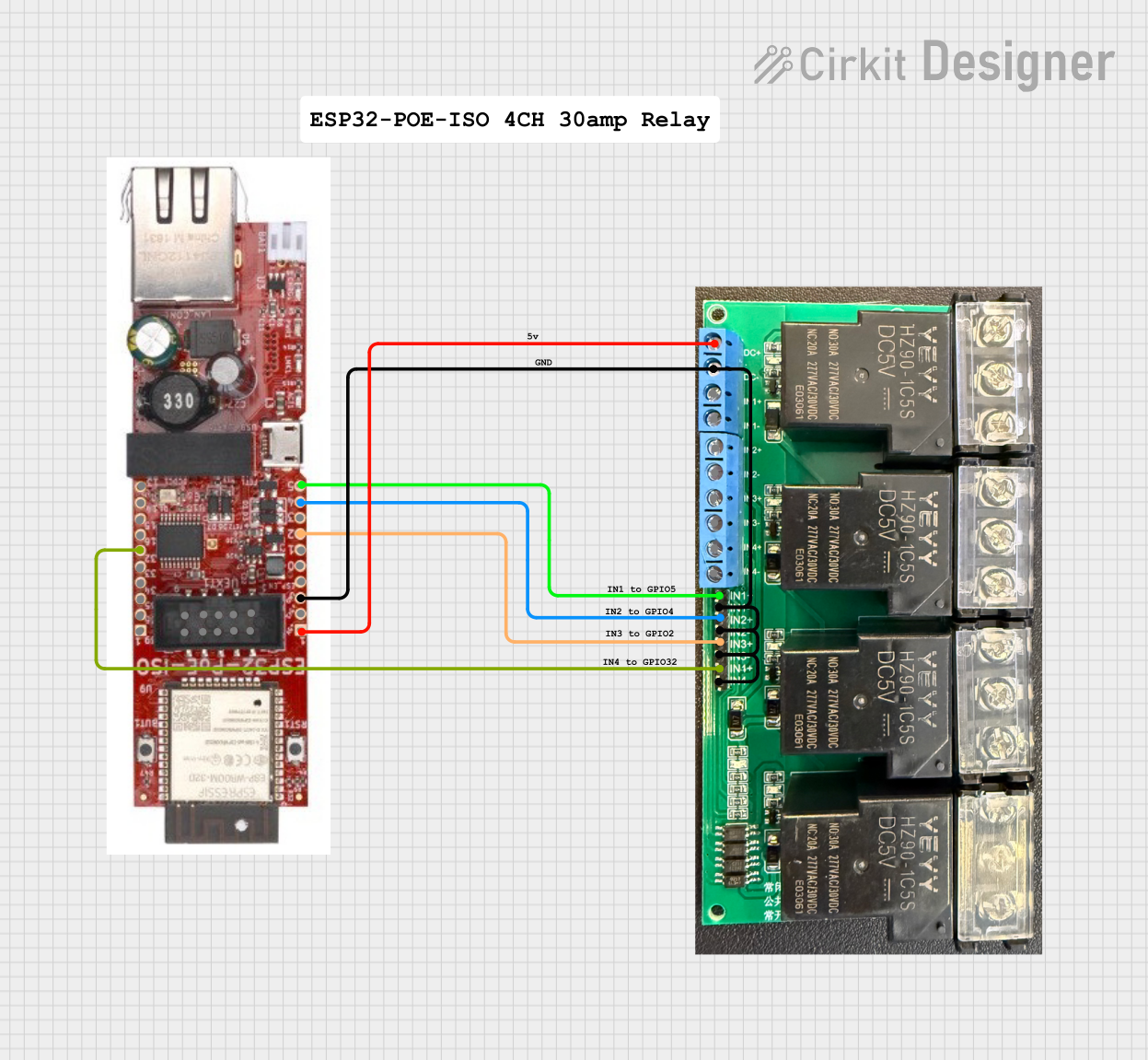
 Open Project in Cirkit Designer
Open Project in Cirkit Designer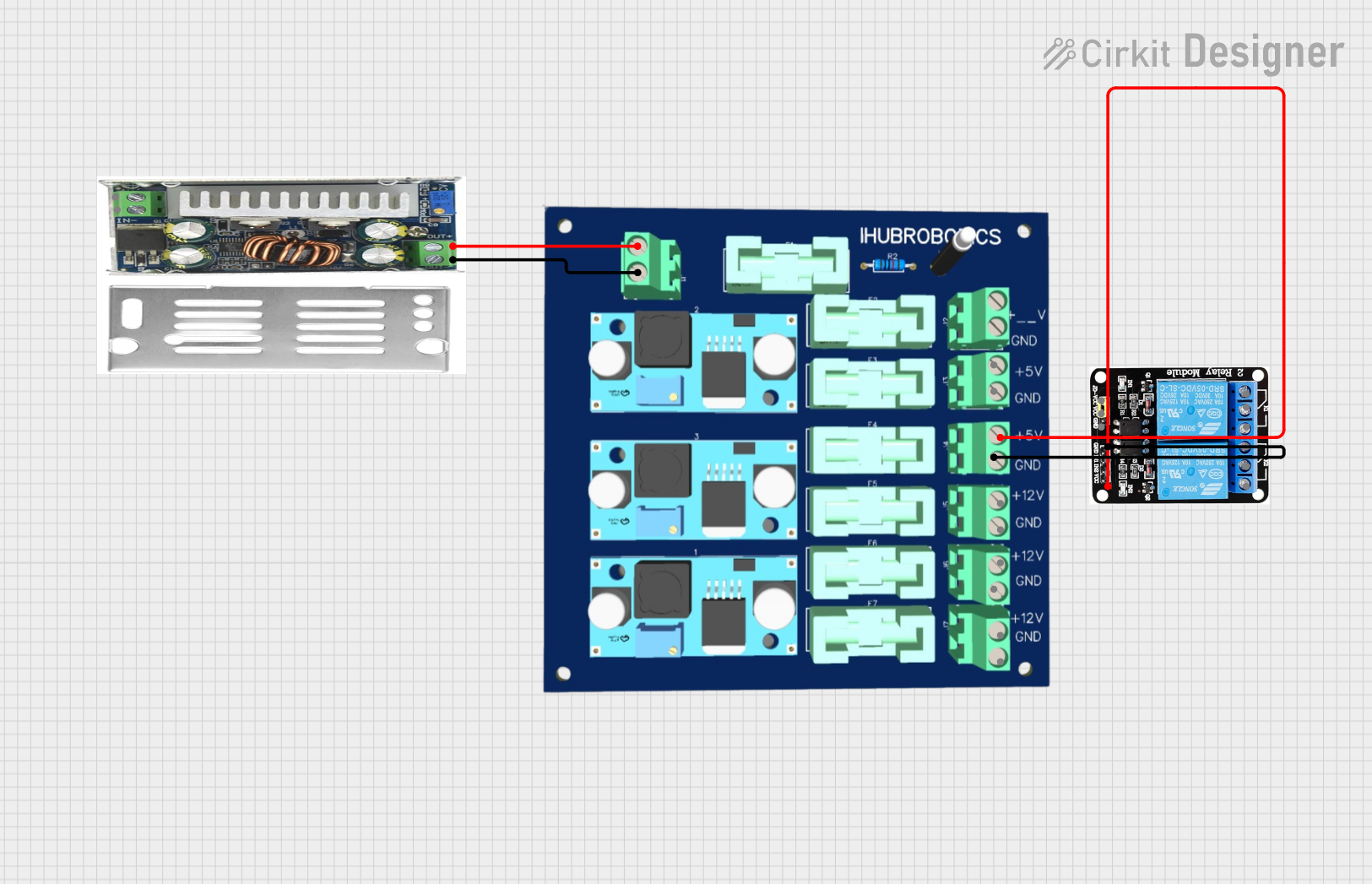
 Open Project in Cirkit Designer
Open Project in Cirkit Designer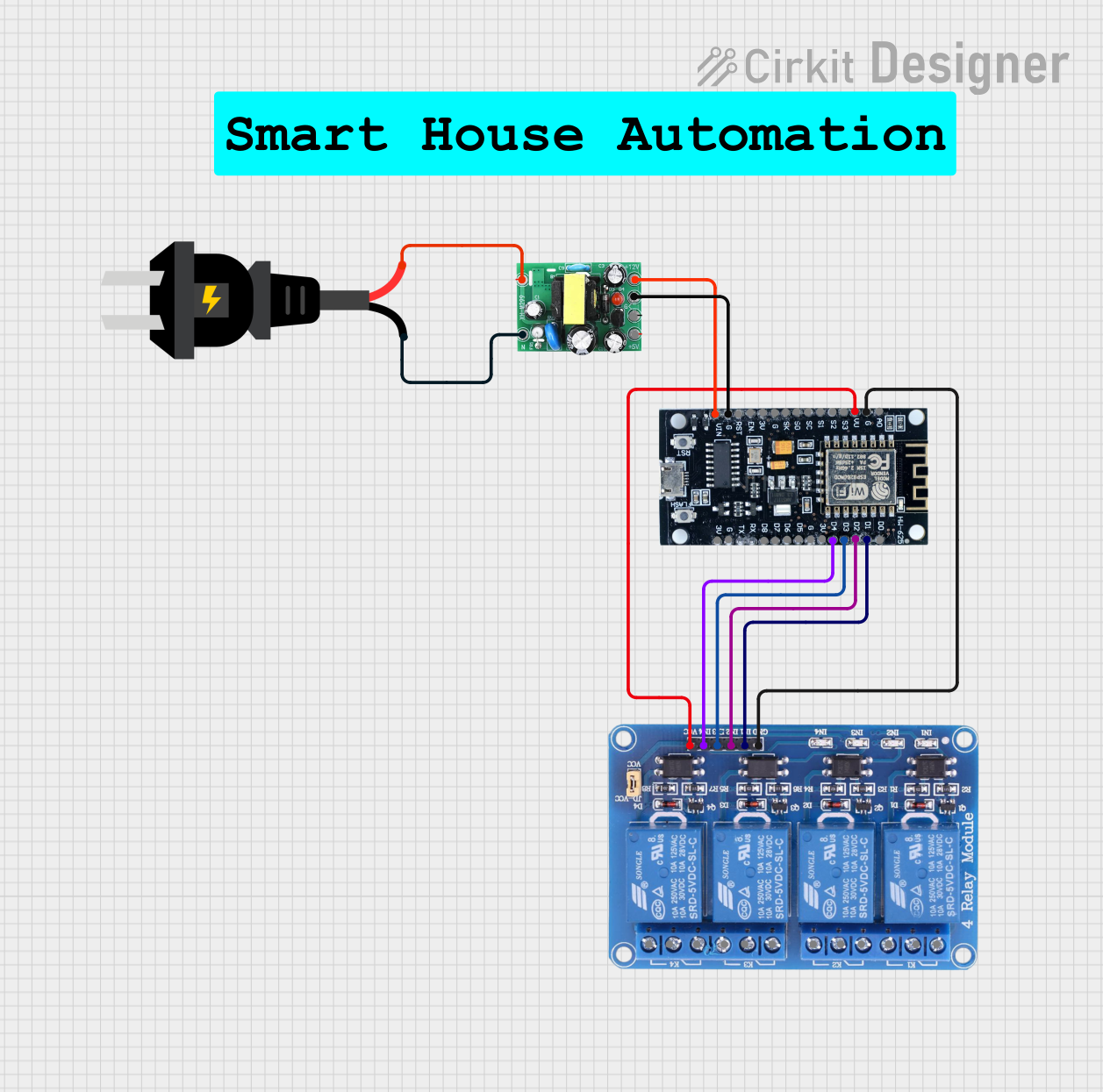
 Open Project in Cirkit Designer
Open Project in Cirkit Designer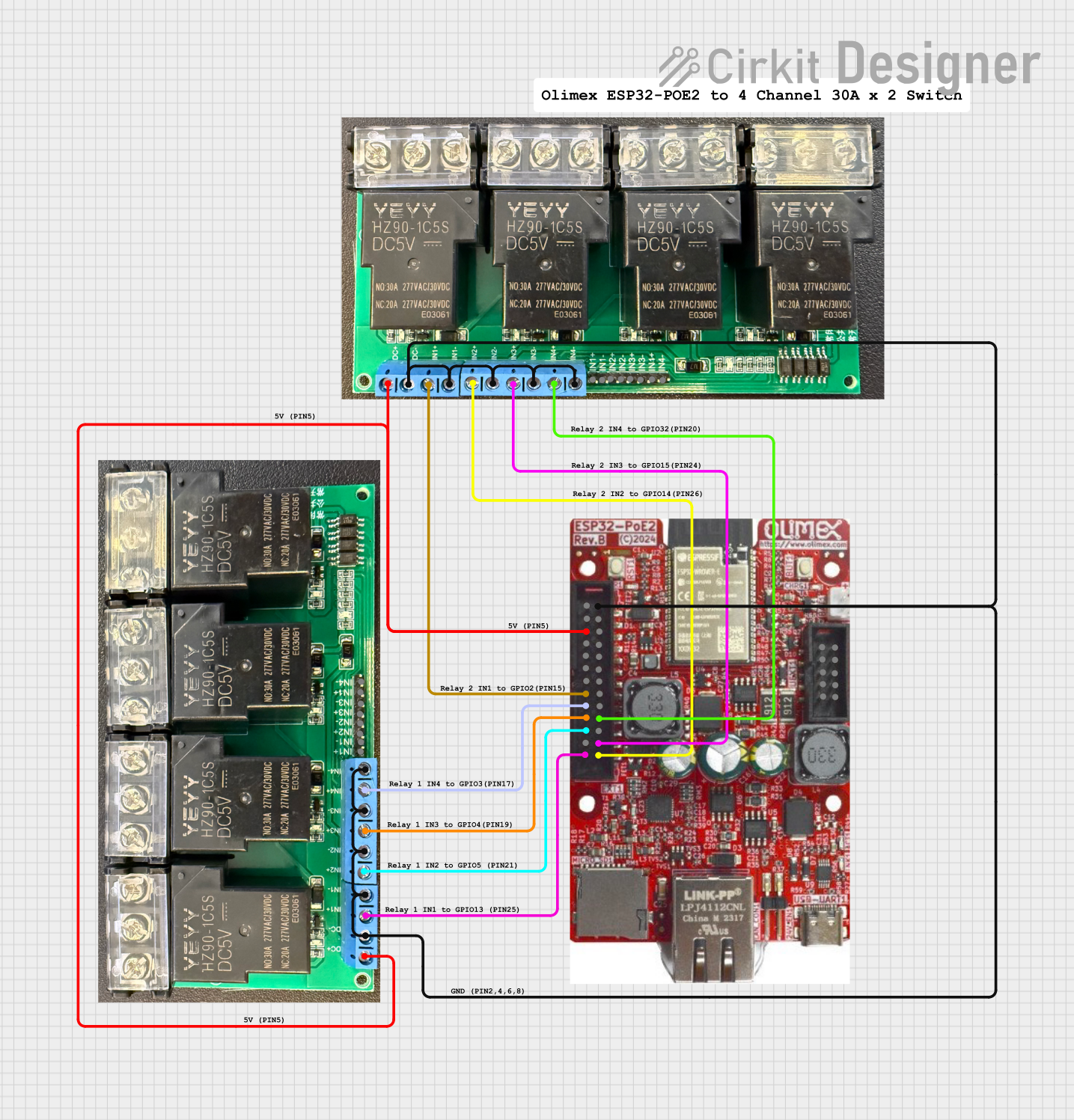
 Open Project in Cirkit Designer
Open Project in Cirkit DesignerExplore Projects Built with Relay Module 5V 4 CH 30A

 Open Project in Cirkit Designer
Open Project in Cirkit Designer
 Open Project in Cirkit Designer
Open Project in Cirkit Designer
 Open Project in Cirkit Designer
Open Project in Cirkit Designer
 Open Project in Cirkit Designer
Open Project in Cirkit DesignerCommon Applications
- Home automation systems (e.g., controlling lights, fans, or appliances)
- Industrial equipment control
- Robotics and motor control
- IoT (Internet of Things) projects
- DIY electronics and prototyping
Technical Specifications
Key Specifications
| Parameter | Value |
|---|---|
| Operating Voltage | 5V DC |
| Relay Channels | 4 |
| Maximum Load (AC) | 250V AC @ 30A |
| Maximum Load (DC) | 30V DC @ 30A |
| Trigger Voltage | 3.3V to 5V |
| Isolation | Optocoupler isolation |
| Dimensions | ~135mm x 55mm x 20mm |
| Weight | ~120g |
Pin Configuration and Descriptions
Input Pins
| Pin Name | Description |
|---|---|
| IN1 | Control signal for Relay 1 (Active LOW) |
| IN2 | Control signal for Relay 2 (Active LOW) |
| IN3 | Control signal for Relay 3 (Active LOW) |
| IN4 | Control signal for Relay 4 (Active LOW) |
| VCC | 5V DC power supply input |
| GND | Ground connection |
Output Terminals (Relay Contacts)
Each relay channel has three terminals:
| Terminal Name | Description |
|---|---|
| NO (Normally Open) | Open circuit when the relay is inactive; closed when the relay is active. |
| NC (Normally Closed) | Closed circuit when the relay is inactive; open when the relay is active. |
| COM (Common) | Common terminal for the relay switch. |
Usage Instructions
How to Use the Relay Module in a Circuit
- Power the Module: Connect the VCC pin to a 5V DC power source and the GND pin to ground.
- Connect Control Signals: Use a microcontroller (e.g., Arduino UNO) or other control circuit to send signals to the IN1, IN2, IN3, and IN4 pins. A LOW signal (0V) activates the corresponding relay.
- Connect the Load: For each relay channel, connect the load to the NO (Normally Open) or NC (Normally Closed) terminal, depending on the desired behavior:
- Use NO if the load should be off by default and turn on when the relay is activated.
- Use NC if the load should be on by default and turn off when the relay is activated.
- Ensure Proper Isolation: The module includes optocouplers for isolation, but ensure that the high-voltage side is properly insulated and safe to handle.
Example: Controlling the Relay Module with Arduino UNO
The following example demonstrates how to control the relay module using an Arduino UNO. In this setup, the relays are activated sequentially.
Circuit Connections
- Connect the VCC and GND pins of the relay module to the 5V and GND pins of the Arduino UNO.
- Connect the IN1, IN2, IN3, and IN4 pins of the relay module to Arduino digital pins 2, 3, 4, and 5, respectively.
Arduino Code
// Define the relay control pins
#define RELAY1 2 // Relay 1 connected to digital pin 2
#define RELAY2 3 // Relay 2 connected to digital pin 3
#define RELAY3 4 // Relay 3 connected to digital pin 4
#define RELAY4 5 // Relay 4 connected to digital pin 5
void setup() {
// Set relay pins as outputs
pinMode(RELAY1, OUTPUT);
pinMode(RELAY2, OUTPUT);
pinMode(RELAY3, OUTPUT);
pinMode(RELAY4, OUTPUT);
// Initialize all relays to OFF (HIGH state)
digitalWrite(RELAY1, HIGH);
digitalWrite(RELAY2, HIGH);
digitalWrite(RELAY3, HIGH);
digitalWrite(RELAY4, HIGH);
}
void loop() {
// Activate each relay sequentially
digitalWrite(RELAY1, LOW); // Turn ON Relay 1
delay(1000); // Wait for 1 second
digitalWrite(RELAY1, HIGH); // Turn OFF Relay 1
digitalWrite(RELAY2, LOW); // Turn ON Relay 2
delay(1000); // Wait for 1 second
digitalWrite(RELAY2, HIGH); // Turn OFF Relay 2
digitalWrite(RELAY3, LOW); // Turn ON Relay 3
delay(1000); // Wait for 1 second
digitalWrite(RELAY3, HIGH); // Turn OFF Relay 3
digitalWrite(RELAY4, LOW); // Turn ON Relay 4
delay(1000); // Wait for 1 second
digitalWrite(RELAY4, HIGH); // Turn OFF Relay 4
}
Important Considerations and Best Practices
- Power Supply: Ensure the 5V power supply can provide sufficient current for the relay module. Each relay may draw up to 70-100mA when activated.
- High-Voltage Safety: When switching high-voltage loads, ensure proper insulation and avoid touching the relay terminals.
- Flyback Diodes: If controlling inductive loads (e.g., motors), use flyback diodes across the load to protect the relay contacts from voltage spikes.
- Active LOW Logic: The relays are triggered by a LOW signal. Ensure your control circuit accounts for this logic.
Troubleshooting and FAQs
Common Issues and Solutions
Relays Not Activating
- Cause: Insufficient power supply.
- Solution: Ensure the 5V power source can provide adequate current for all active relays.
Microcontroller Resetting When Relays Activate
- Cause: Voltage drop due to high current draw.
- Solution: Use a separate power supply for the relay module and connect the grounds of the microcontroller and relay module.
Load Not Switching Properly
- Cause: Incorrect wiring of the load to the relay terminals.
- Solution: Verify the load is connected to the correct terminals (NO, NC, and COM).
Relays Stuck in ON or OFF State
- Cause: Damaged relay contacts due to overcurrent or arcing.
- Solution: Replace the damaged relay module and ensure the load does not exceed the rated current.
FAQs
Can I use this module with a 3.3V microcontroller?
- Yes, the module supports trigger voltages as low as 3.3V. However, ensure the microcontroller can provide sufficient current to drive the optocouplers.
What is the lifespan of the relays?
- The relays are rated for approximately 100,000 operations under normal load conditions.
Can I control DC loads with this module?
- Yes, the module can switch DC loads up to 30V at 30A.
Is it safe to use this module for high-voltage applications?
- Yes, but ensure proper insulation and follow safety guidelines when working with high voltages.